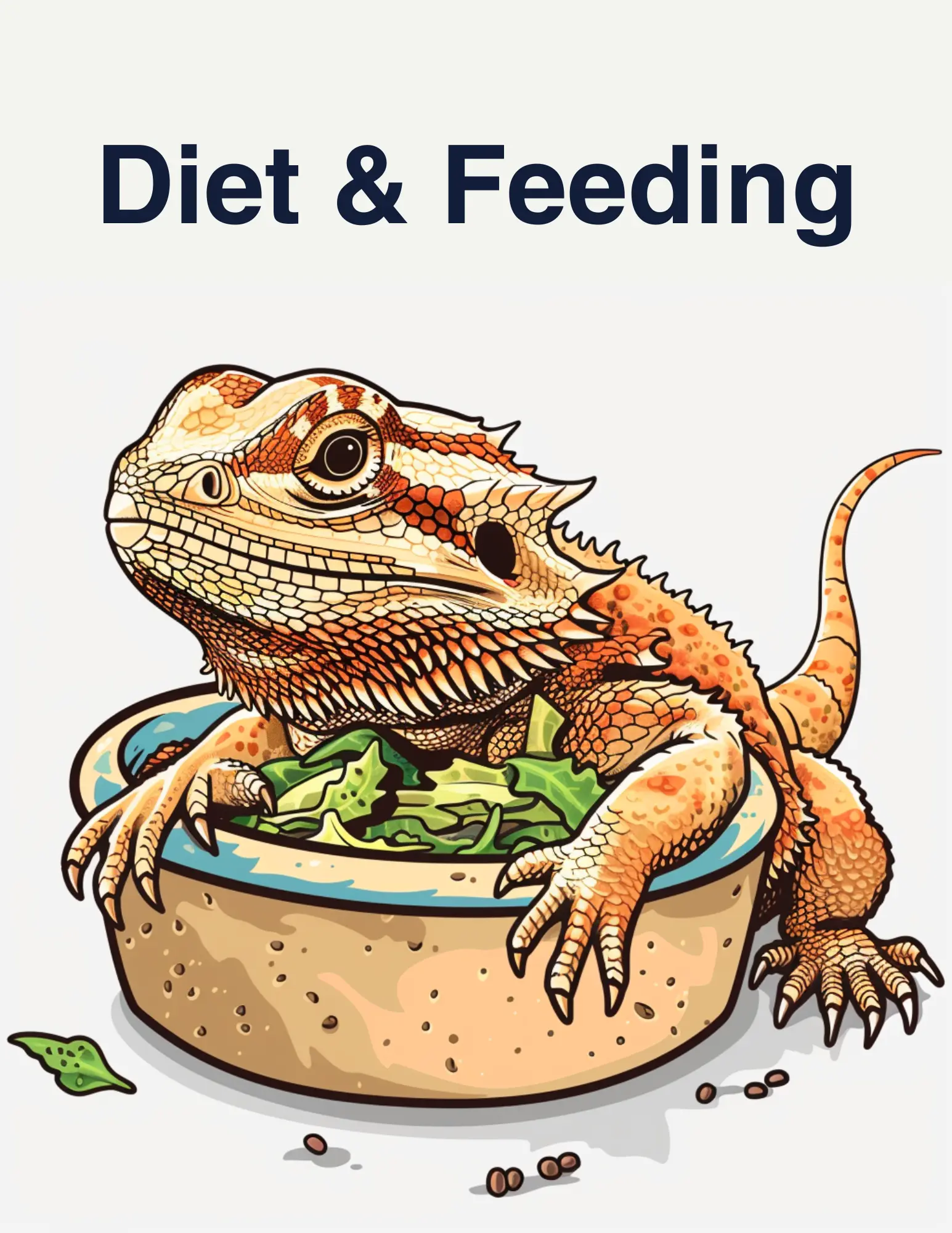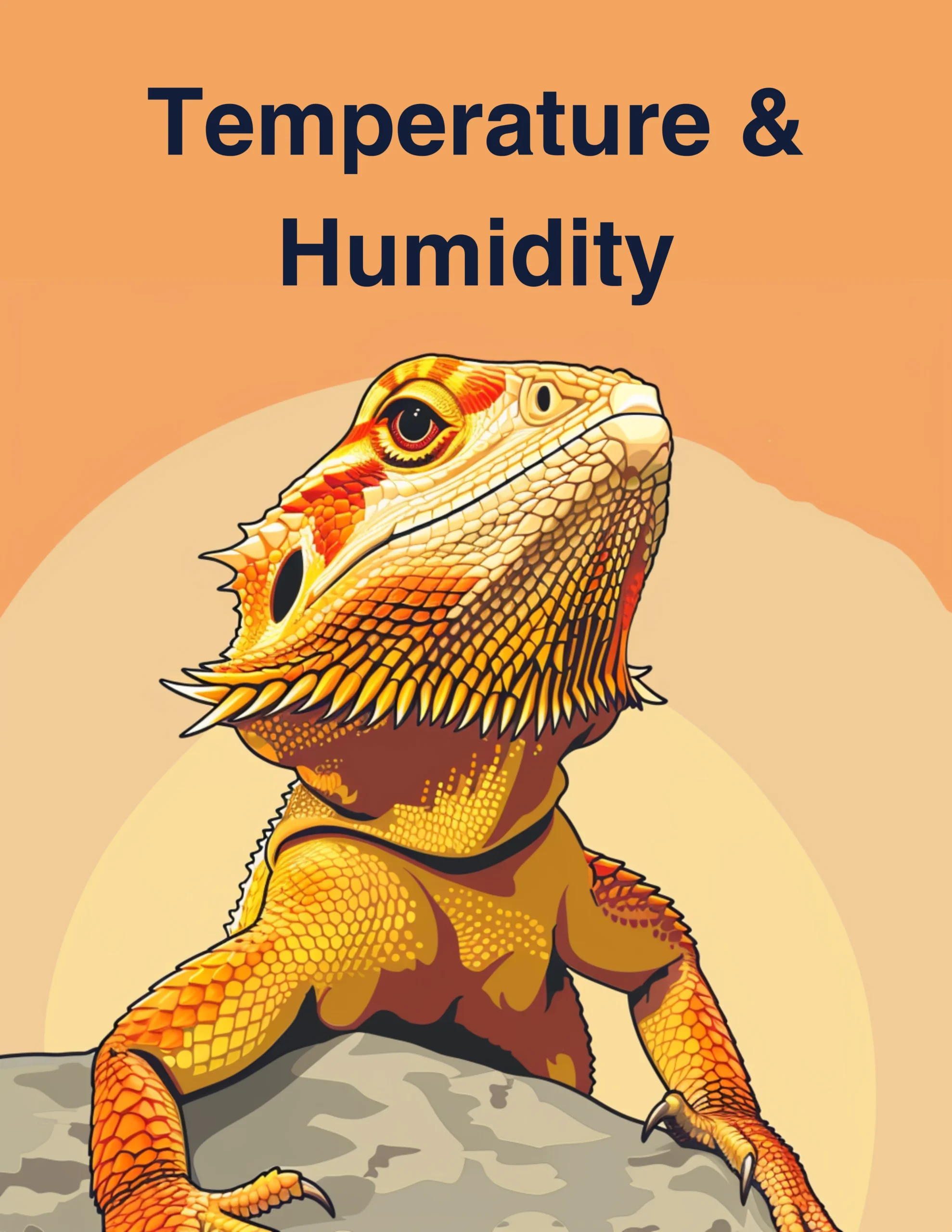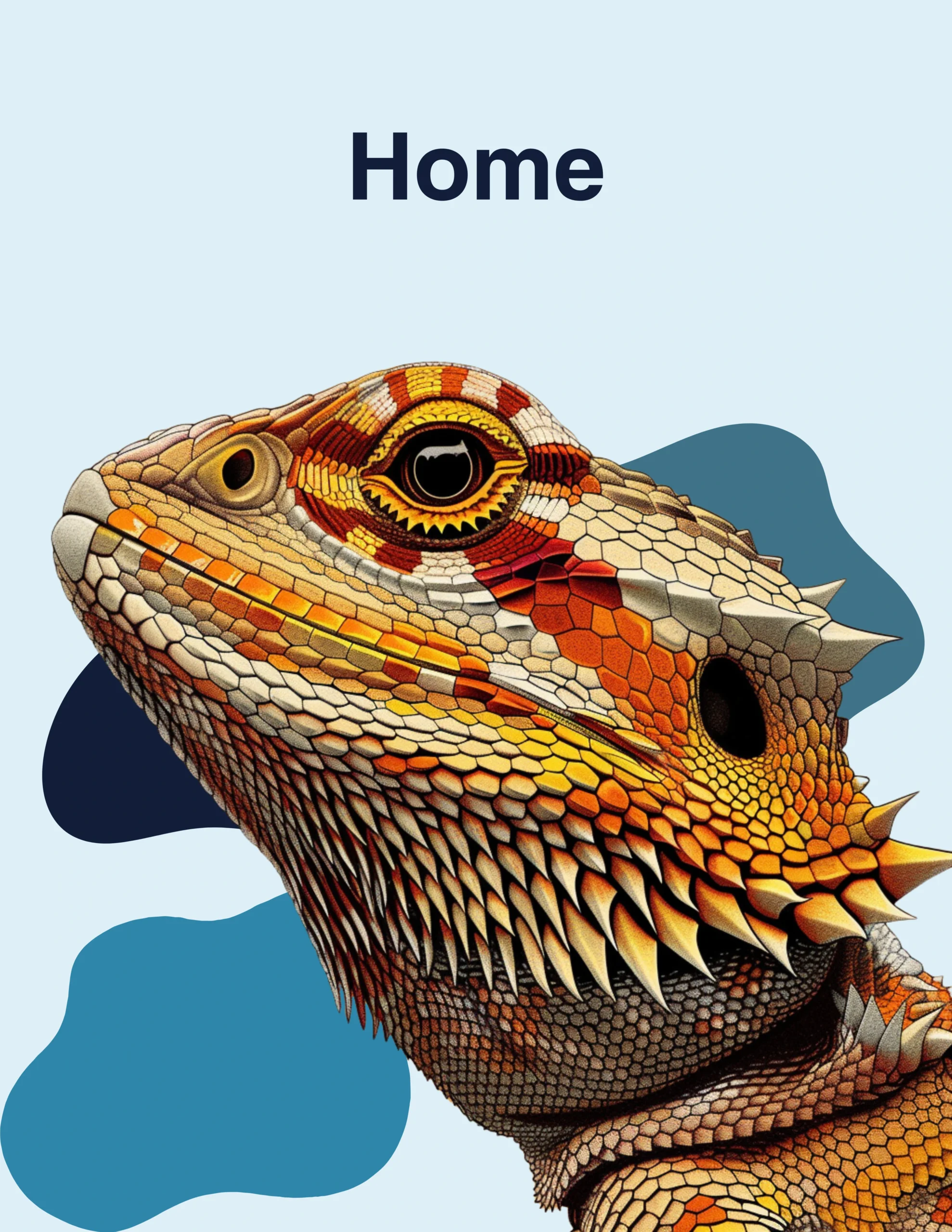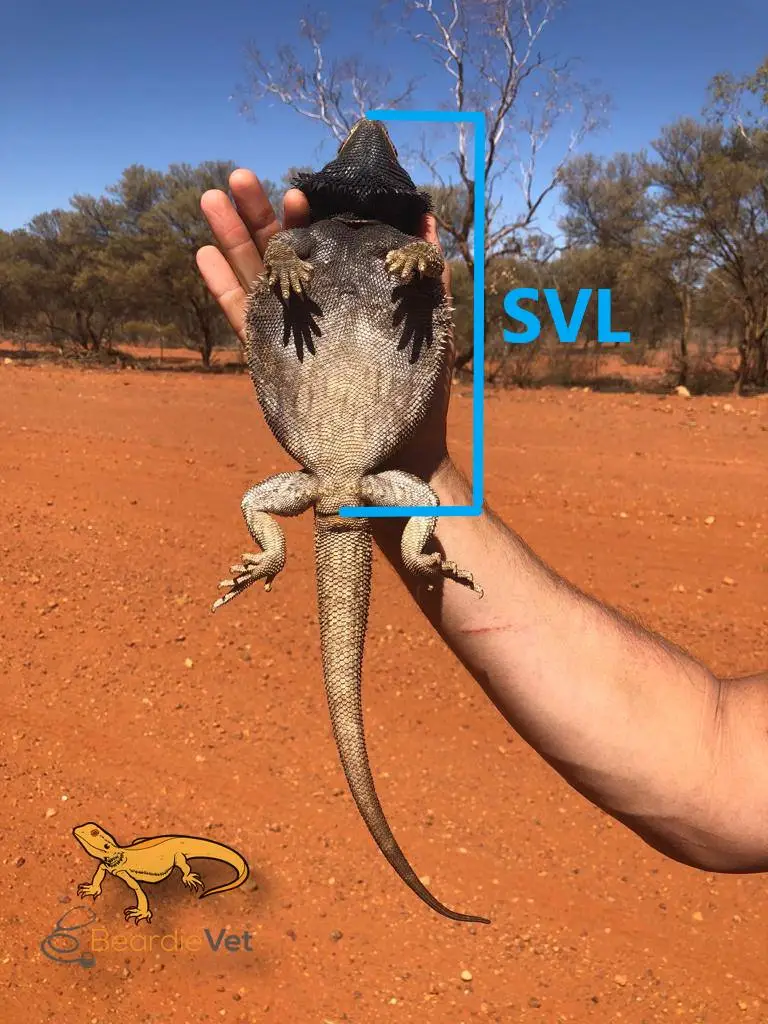
Enclosure and Set-up
Bearded Dragon Care Guide
Enclosure Overview
Min Size:
6x3x3 Feet
Keep reading to understand "why"
Required Budget:
$200-$2,000
Priority Level:
Medium
The enclosure and the various things inside of it are key to your pet’s overall health and well-being. After all, your pet will spend most if not all of their time inside this space, so we better make sure it’s well suited for their needs.
Designing and setting up a new enclosure (or reworking one you have) can be one of the most rewarding aspects of caring for your pet. You get to build your own slice of Australia and keep it right in your home.
There are a couple key things we need to learn, so let’s dive in.

We’re not self proclaimed experts. Everything here is cited and attributed to well educated and experienced researchers, vets, and non-profits. Don’t trust any site that does it differently. They’ll almost always packed full of bad info. Want to see our source? Just click the check.
Picking an Enclosure
There’s a lot of conflicting advice on how big a bearded dragon enclosure should be. The truth is: bigger is (almost) always better. Depending on the size of your dragon:
- For Babies, Juveniles, and small adults (a SVL of less than 8 inches) you should use at least a 4 foot by 2 foot by 2 foot enclosure.
- For anything larger, which means almost all adults, use a 6 foot by 3 foot by 3 foot enclosure.
Now if you’ve skimmed through other care resources, you might be thinking…
“THAT BIG? I thought it was ok to have a much smaller set up?”
If this is you, don’t worry. We have evidence to back this claim. We’ll explain why this matters, and how we reached this number. Unfortunately, it’s quite common for breeders and pet stores to encourage smaller enclosures, because they don’t want to scare anyone out of making a purchase.
We can’t tell you what to do, but we’ll do our best to show you why a 6x3x3 enclosure is the best option for you and your family.
Having a properly sized enclosure:
The science and research behind our recommendation
Our research shows how to determine minimum enclosure size for bearded dragons scientifically. Many other care resources lack evidence-based guidelines, causing inconsistent advice.
Experts like the authors of “Assessing Reptile Welfare Using Behavioral Criteria” , caution that providing minimum enclosure sizes may help prevent health issues but won’t meet long-term behavior needs. We have kept this in mind, while also acknowledging that these animals are kept as pets.
First, let’s look at how much space they need in the wild. A study done in 2022 found that bearded dragons often have home ranges that are 100 meters wide or larger. That’s bigger than a football field. Bearded dragons instinctively move to find food, mates, and optimal temperatures.
This tells us two things:
- No enclosure is too big
- Captive enclosures are a tiny fraction of the bearded dragon’s natural range
Since football-field-sized enclosures are impractical, the authors of “Guidelines for Inspection of Companion and Commercial Animal Establishments” have come up with a technique to provide a more realistic standard. An enclosure should allow an animal to express all its natural behaviors, especially its ‘flee’ response, which requires the most space. Their estimation suggests a minimum enclosure size of 6 feet by 3 feet ground space. This recommendation comes from a respected group of veterinary scientists, backed by extensive research.
Another group, the Federation of British Herpetologists recommends similar enclosure sizes for bearded dragons. In rough terms, they recommend a 4x2x2 for smaller immature dragons, and a 6x3x3 for adults.
Finally, we contacted a team we’ve worked closely with before, My Nature Lab . They house well over 100 reptiles for their educational programs with stunning success. Cameron, their founder and executive director, advocates for even larger enclosures. He suggested providing as much space as possible, even if that means taking over entire parts of a room to house the enclosure. For their standards, a 6x3x3 is satisfactory, but they often opt for an 8x3x3 or a larger custom designed option instead.
This is the consensus from all reputable sources:
- Go as big as possible
- 6x3x3 is minimum for an adult, but smaller animals can be housed in smaller enclosures
Why is the right size enclosure so important (the science)?
Bearded dragons have a wild home range of over 90,000 square feet. Their natural behaviors, which typically require a fair amount of space, are not just preferences – they are vital for maintaining body condition, proper temperature control and general health. Confining them to a very small size is unnatural and harmful.
Temperature
In a large enclosure, you can create a smoother temperature gradient. Research shows that an overly steep thermal gradient impacts a bearded dragon’s ability to correctly regulate their temperature. Poor internal temperature control can harm their digestion, activity levels, and overall health.
In a larger enclosure, temperature-related mistakes are less disruptive. If one spot is too hot or too cool, the rest of the enclosure will not be overly affected as it would be in a smaller enclosure.
The ability to engage in all natural behaviors
Basic Common Sense
Like the human phobia of small spaces, other animals become stressed when trapped in tight spaces. There is a key difference between being stuck in a small space, and being able to retreat to a small space when threatened.
Big Enclosure = Better Pet Ownership Experience: a healthier pet, and fewer health problems for you to worry about
Why should I care about the right size enclosure?
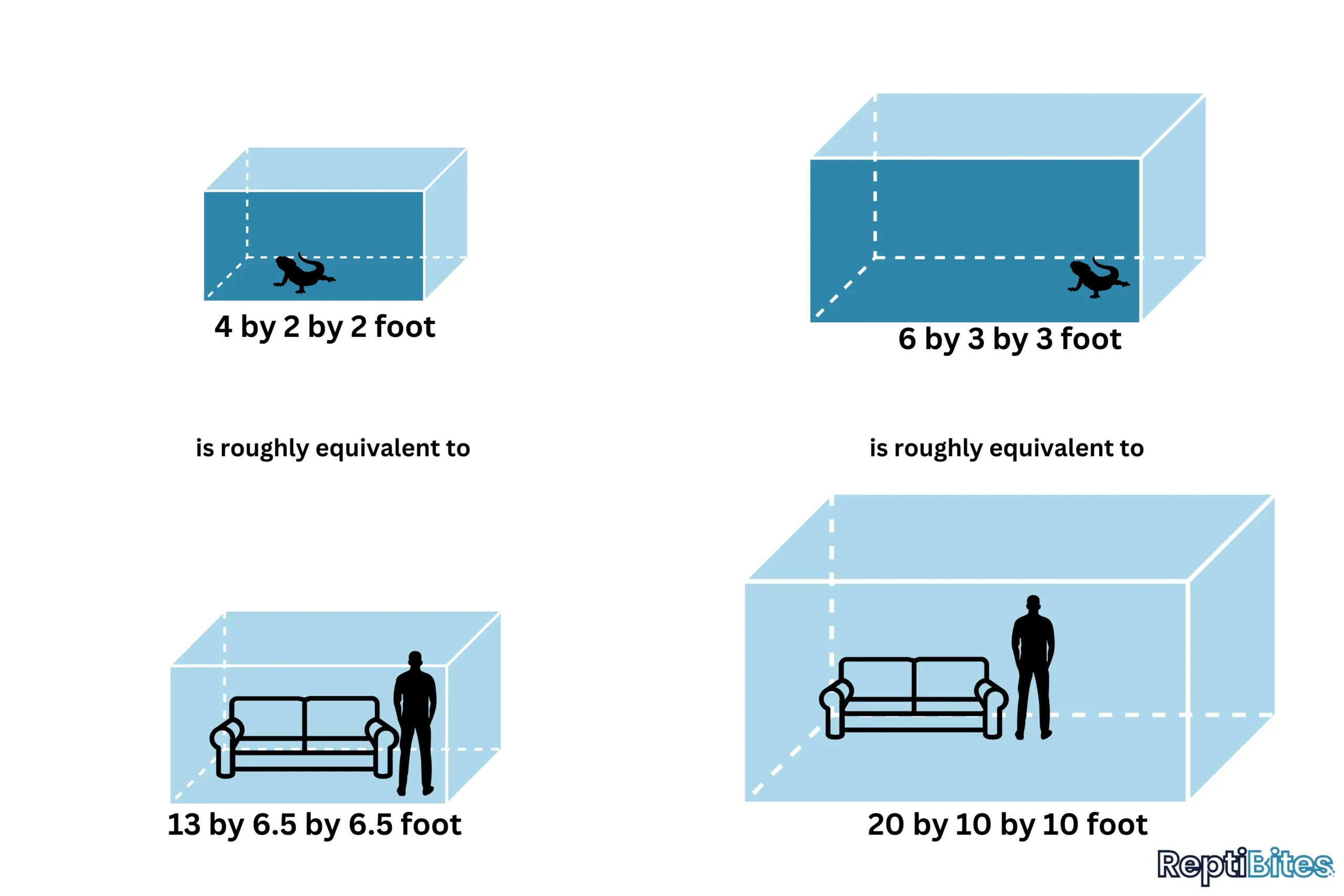
If the above evidence hasn’t convinced you to get a 6x3x3 enclosure, let’s take another approach to visualize what a smaller enclosure feels like to your pet.
A full-grown bearded dragon inside of 4x2x2 is like you living in a 13×6.5×6.5 foot room, half the size of a typical bedroom, and never leaving.
Now compare this to a 6x3x3 which equates to roughly a 20 foot by 10 foot room, a massive improvement.
Finally, an 8x3x2 provides the space of a small living room; while not perfect, it’s a pretty major improvement over the cramped 4x2x2.
Housing an adult bearded dragon in an enclosure smaller than 6x3x3 is like a human living inside a walk-in closet. Cutting corners here means confining your pet to a tiny space, which can lead to a number of behavioral issues and an unhealthy environment.
Even on a budget or space limitation, there are ways to provide the space your dragon needs. Don’t settle for less.
Getting the right enclosure at all budgets
If Quality and Visual appeal are more important than budget:
Estimated Spend
$500-$2,000
Visual Appeal
High
Time Investment
Low-Medium
If you’re looking for something high quality, that will look great inside your home, this is the right option for you.
There are a wide variety of enclosure options from various reputable companies. A simple google search for ‘6x3x3 enclosure’ will get you started on your search. We recommend watching some basic YouTube reviews to get an idea of the materials, durability, and ease of set up. Depending on your home and where you plan to put it, some features will stand out to you.
Brands that have solid reputations:
Kages – A high level premium option
Zen Habitats – A slightly more moderately priced option
If you can’t find an enclosure with the exact dimensions of 6x3x3, you can look for enclosures that have a the same or greater ground area and volume. For reference, the ground area of a 6x3x3 is 18 square feet (6 x 3) and the total volume is 54 cubic feet (6 x 3 x 3).
We wish we could give you more concrete input, but ultimately choosing the right enclosure is a very personal choice. Take some time and search around to find something you like.
We aren’t on a budget, but I don’t feel like spending a ton of money
Estimated Spend
$400-$800
Visual Appeal
Medium-High
Time Investment
Medium-High
In this budget range you can build your own enclosure, modify an existing one, or try to find a second-hand option.
If you’re handy and have basic tools (saw, drill, etc), building a custom enclosure can be extremely rewarding. You can customize it to fit your space, and there are some excellent YouTube resources to guide you. A really great resource on YouTube if you want to explore building your own enclosure. Brad makes some very thoughtful enclosures, some of which may be too complex for your needs, but it’s great inspiration nonetheless: https://www.youtube.com/@bradsbioactivebuilds. See the below example of a turtle enclosure built into a corner.

Alternatively, you can search for an enclosure on craigslist, Facebook marketplace, or other resale sites. It can be difficult to find enclosures of a larger size. There’s a plethora of 20-40 gallon enclosures for resale, but as discussed, this really doesn’t come close to what a bearded dragon will need.
Finally, some pet owners combine two 4x2x2 enclosures to make one long 8x2x2. This lets you start with a smaller enclosure and expand as your dragon grows, spreading out the cost over time. This set up does offer less vertical space than a 6x3x3, so it’s not ideal if you’re using your vertical space correctly (see below in this guide).
Best Budget Friendly Options (that still get the job done)
Estimated Spend
$200-$300
Visual Appeal
Low
Time Investment
Low-Medium
Full credit to our friends at My Nature Lab for this idea. Instead of describing it, we’ll show you:
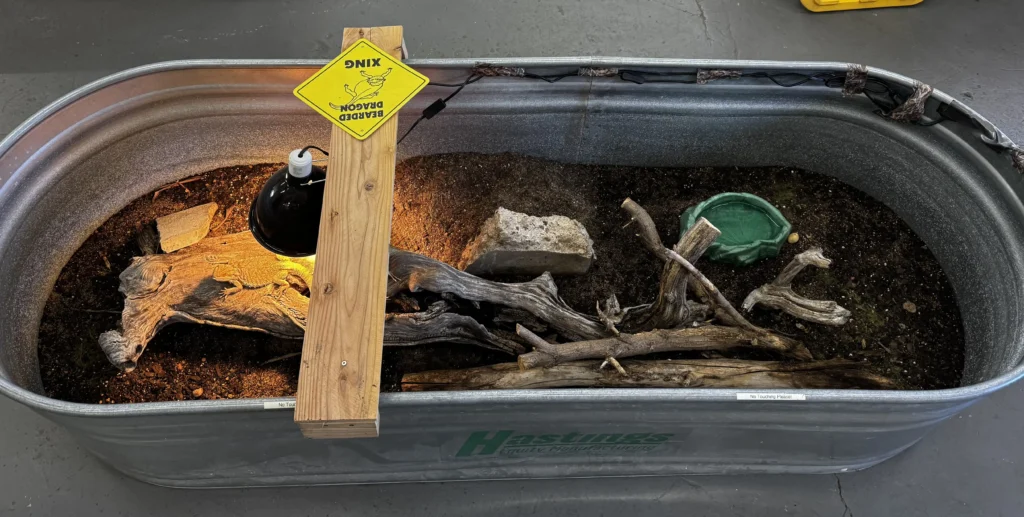
They use large cattle troughs to provide adequate space to the reptiles they care for at their educational facility.
While they are not visually appealing, they are extremely functional. They’re watertight, built for livestock, and made of durable galvanized steel-offering a great value and price per square foot.
In almost all circumstances, you’ll need to add a lid or a frame to hang lights on. Especially if you keep it in a heavily trafficked area or if the trough isn’t deep enough to prevent escapes. If you have other pets, this set up might be a bad idea. It depends on your situation and where you can house the set up.
Building a lid is straightforward, and a local handyman can likely do it for a low cost. If you’re handy you can build one yourself. Check out this resource for an idea of how it can come together: https://www.youtube.com/watch?v=ztVt0BhO894
One concern of this set up is that predators in the wild often come from above, so an open-top enclosure on the ground could cause some stress in your pet.
The team at My Nature Lab is aware of this potential downside, but stress that the benefits of a properly sized enclosure far outweigh this concern. They found their reptiles adjusted quickly – especially when food is offered from above.
Finding Solutions: Budget and Space
We understand that finding the space for an 6-8 foot tank can feel overwhelming. If you’re thinking: “There is just no way I can fit an enclosure this big in my home.” We think you might be wrong, and we encourage you to explore some creative solutions.
You can almost certainly find a place to put an enclosure, even if it means you have to replace some of your other furniture. A well-designed enclosure is just as much a work of art as it is a home for your pet. They can look absolutely stunning, and provide a touch of nature to any room.

This isn’t a bearded dragon enclosure, but it’s a great example of a well designed enclosure that looks incredible:
If budget is your concern, we can empathize. We know enclosures are not nearly affordable enough. As it stands, the only alternative is providing your pet a poor environment to live. We cannot endorse a sub optimal strategy. There are more affordable ways to create a functional setup, and we encourage you to explore these options.
If all else fails, a bearded dragon might not be right for you. There’s no shame in this. We would argue it’s much worse for your mental well-being and your pet’s health to provide a sub-optimal environment instead of acknowledging someone else has the chance to do it better.
If you have not purchased an animal yet, you could consider looking into Rankin’s Dragons, a close relative of the central bearded dragon most common in the pet trade. The Rankin’s dragons are smaller, and a smaller enclosure (at least 4x2x2) may be possible depending on the size of your specific pet. This said, everything discussed still applies: Larger enclosures are just better.
Should you choose to go smaller
We understand that some people will go this route. If you choose to get a smaller enclosure for your pet than you should, whether it’s because of budget, or space constraints, there are a couple things to keep in mind.
You will need to be extremely precise in how you set up the space you do have. In smaller enclosures, mistakes with temperature, lighting, and essential elements like hides and basking spot are easier to make and can have more serious consequences.
A smaller enclosure should only be a short-term solution. Make plans to provide adequate space for your pet, whether it means saving up, or spending some time building your own.
Whatever you do, do not go smaller than a 4x2x2 foot enclosure.
Substrate, Hides, Furnishings: The Enclosure Elements

Substrate options
Let’s start from the ground up. What should you use for substrate?
As far as science and care standards are concerned, there is only one good option: a soil/sand mixture that replicates the environment of their natural habitat.
Specifically, a 50/50 mix of organic topsoil (no fertilizer or additives) and play sand, both of which are very affordable and can be found at your local hardware store. Simply mix them in a 50/50 proportion, and completely soak with water. Pour off any excess water. This step can help remove any excess dust from the sand. You may want to repeat this step multiple times, depending on the sand you are using. Pack the mixture into your enclosure so it is at least 3-4 inches deep. Let it dry out before putting your pet in their new home.
Some sources suggest the addition of excavator clay to help the substrate hold its shape better. We have not personally tried this but see no reason it wouldn’t be a smart addition.
Why is this the only option?
Bearded dragons come from a place that has lots of dirt and sand that they occasionally burrow into. Providing the same environment enables more natural behaviors in captivity. A natural substrate also does a better job of stabilizing temperature and humidity inside the enclosure and gives your pet ways to adjust their own internal temperature via digging.
Alternative substrates do not provide any of this benefit. While some options (like tile, newspaper, or paper towels) aren’t overly dangerous, they should be reserved exclusively for temporary use. The lack of ‘dig-ability’ is a deal breaker as far as we’re concerned. While it may not seem like it, this is a very important behavior. Reptiles tend to try to get lower when too hot. Removing their ability to leverage this instinct combined with improper temperatures can cause major issues.
The remaining substrates suggested by other care sources are certainly sub-optimal and possibly dangerous.
- “Vitamin/Mineral” Sand like calcium sand has the possibility of digestion risks.
- Certain wood shavings are toxic if ingested.
- Shelf liners or manufactured flooring have the same downsides as tile, with the additional concern of manufacturing processes adding harmful compounds and chemicals.
- Reptile Carpet is one of the more ridiculous options available. It is extremely difficult to keep clean, and as a result can harbor bacteria and smell. Many advanced owners also acknowledge it can also pull nails and entire toes off of animals. Frankly, we have no idea why anyone would use this stuff.
This happens to be one area of bearded dragon care that the cheapest option is by far the best. Don’t make the mistake of spending more money than you need to, especially when it’s worse for your pet.
Hides, Furnishings, and basking spots

What would be more comfortable: a house full of various furniture or a house completely empty? Obviously, having places to sit, lay down, and relax is preferred.
Temperature: How warm or cool is that area?
Exposure/Coverage: How exposed is this area to light and how hidden will the animal be in that area?
Distance from the ground: How close to the ground is it?
To enable as many natural behaviors as possible, we should seek to provide as many ‘micro-climates’ with each of these characteristics. For example:
- Basking Rock: High Temperature, High Exposure, High off the ground
- Warm Hide: High Temperature, Low Exposure, Low to the ground
So, we’d aim to provide one of the following to your bearded dragon:
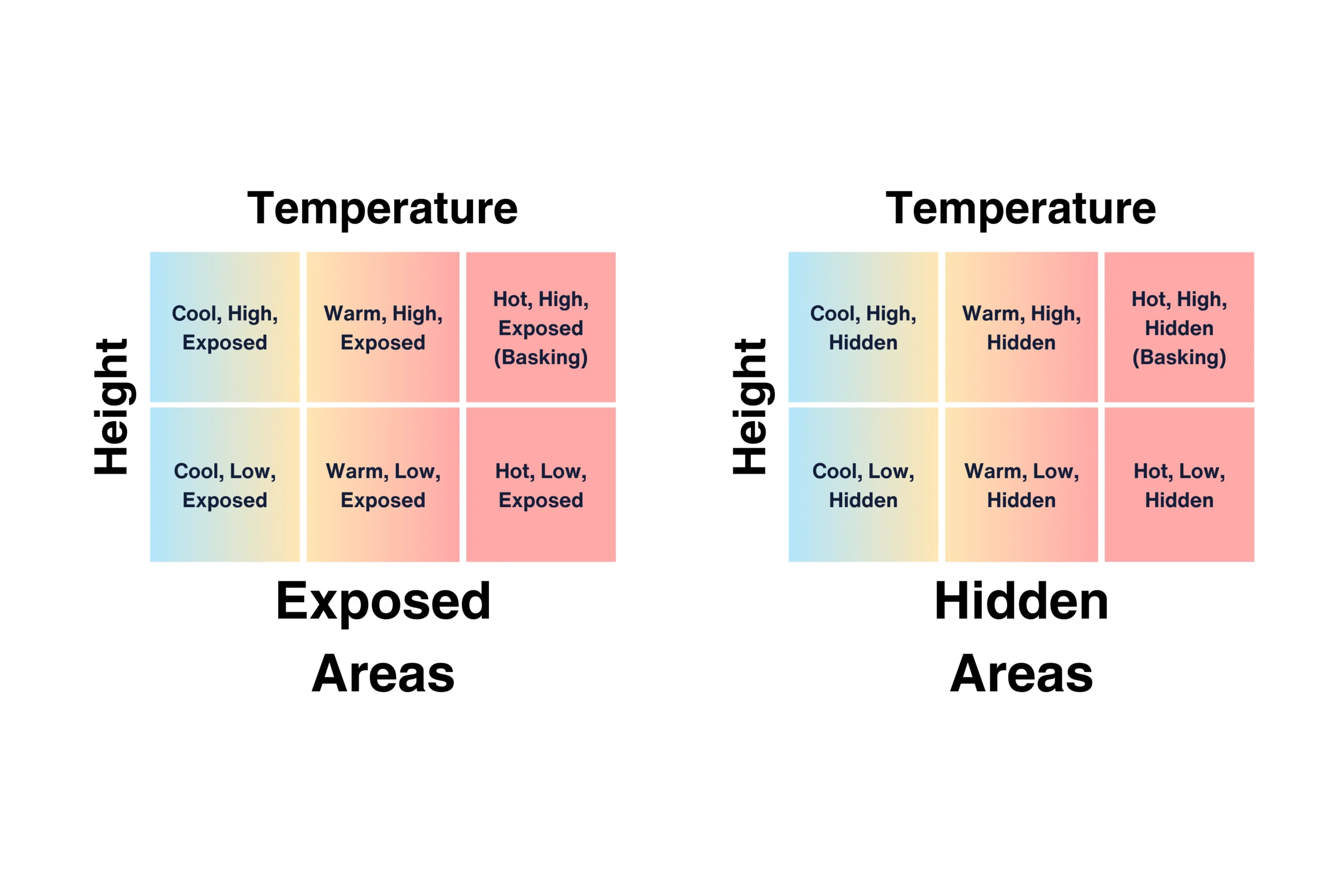
While this system does introduce a little more complexity than the traditional setup of basking location, warm hide, cool hide, ultimately it will provide your pet a much better environment.
The reason it’s so important is bearded dragons are experts at positioning themselves in their environments. They use unique orientations like head in shade and body in sun to better thermoregulate. They use different microclimates (small areas with distinct temperature, humidity and light conditions) within their habitat depending on the time of day, season and temperature. Although not commonly discussed, they are avid climbers. They’re often found basking 2 meters above the ground, and climb higher into trees to cool off and sleep at night.

It’s completely normal for these animals to have access to a wide variety of temperatures, light levels, and vertical height to suit whatever behavioral needs they have. Whenever we prevent an animal from engaging in its natural behaviors, we are doing damage to their health and well-being.
Providing as many of these ‘micro-climates’ as possible will greatly help your animal regulate their temperature, feel safe, and behave in a more interesting way for you as an owner.
Practical Set-up Guide - The necessities
A well exposed, and off the ground basking spot directly under a heat lamp
Essentially, we need something that will hold heat, and get your dragon off the ground. We find large rocks or logs to be the best option. The cheapest (and best) solution is to gather materials from your yard, or other natural areas near you. (Be sure to follow any of your local regulations). Alternatively, there are many local and online retailers that sell rocks, logs, and manufactured fixtures for this purpose. To be clear, this rock should not be heated from below, rather from above using a basking lamp. We’ll break down temperature further in a different section.
A hidden perching spot on the cool side of the enclosure
Wild dragons are commonly found sleeping high in bushes or trees. These places are typically covered from above, and cooler than basking locations. This combination of cooler air, height, and coverage is the perfect place for a dragon to hangout when they want to feel safe.
A half exposed hot/warm area near the basking spot
As explained, bearded dragons oftentimes use orientation to precisely control internal temperature. This oftentimes takes the form of a dragon placing half its body in a warm place, with the other half in a cooler place.
Various hidden areas along your temperature gradient
This gives your bearded dragon the ability to remain hidden, while also regulating their temperature. In total, you should provide three hidden areas: One that is near your basking location, one toward the middle of your temperature gradient, and one on the cool side.
Various branches or rocks that enable your dragon to climb in elevation as desired.
Bearded dragons love to climb and should be provided with branches, rocks, or other features that allow them to elevate as desired. Climbing not only supports their natural behaviors but also helps with exercise and thermoregulation by accessing different temperature zones within the enclosure.
Now if you’re reading this thinking “wow that’s complicated!”, let us explain. Many of these locations can be offered with a few enclosure additions. For example, using a couple pieces of sheet rock to create an elevated basking spot actually covers three of these micro-habitats:
- The basking location at the top
- A hidden area in the hot side of the enclosure (under and in the space created with the sheet rock)
- The option of a half exposed warm area near the basking spot if the dragon crawls partly into the hidden area
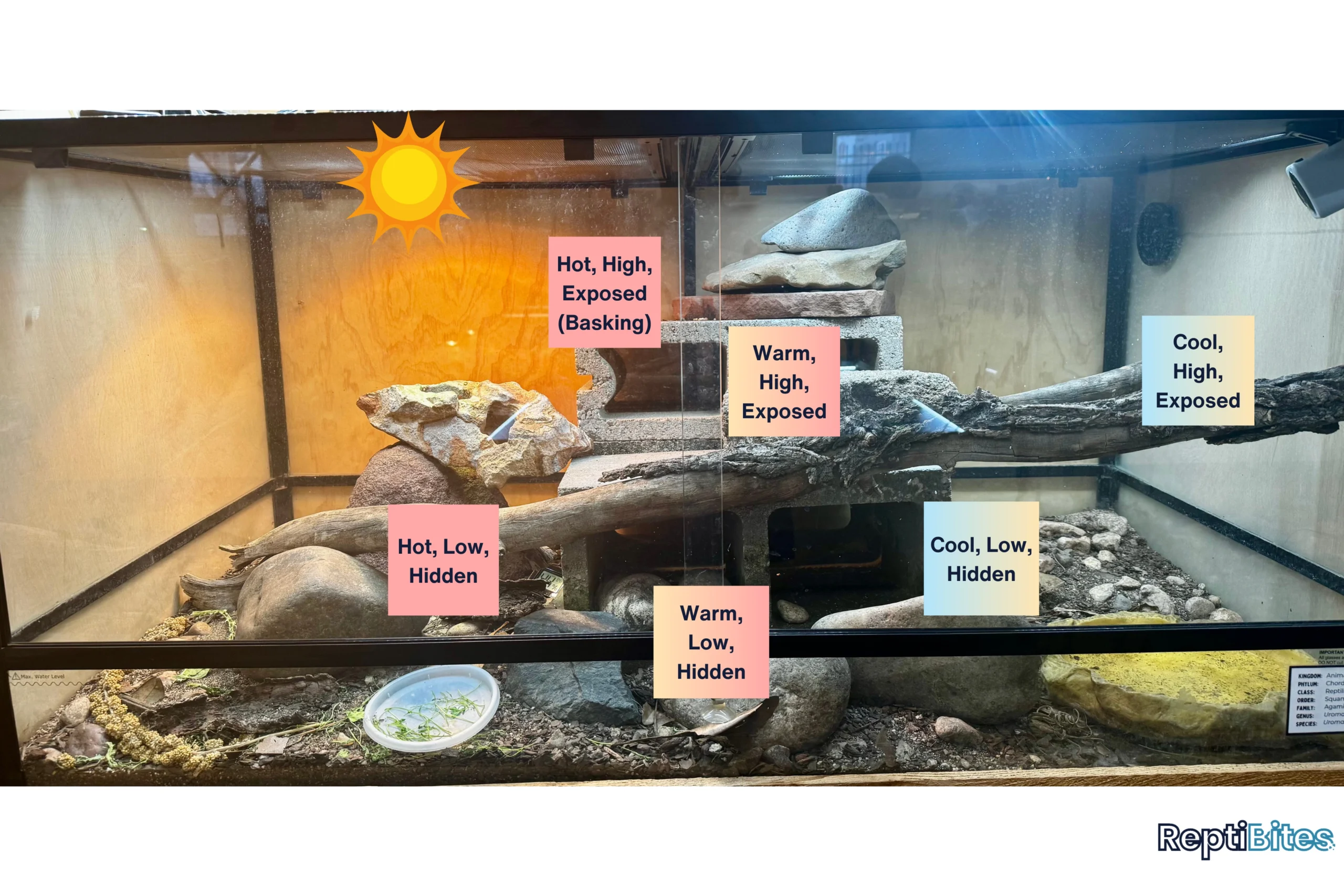
With a bit of creativity and a few additions, you can create these areas quite easily. While we’d love to provide a detailed blueprint for this, this is largely up to personal choice. Where you keep your bearded dragon, the size of your enclosure, and the style you decide to go with will all impact how you want to set this up. Just do your best to provide as many micro-habitats as possible, and be sure you cover the essential ones listed above.
A note on temperature gradient:
We’ll explore this topic more completely in our temperature and environmental conditions guide. It can however be helpful to understand this concept when first laying out your enclosure. Traditionally, temperature gradient is though of in 1D, like this:
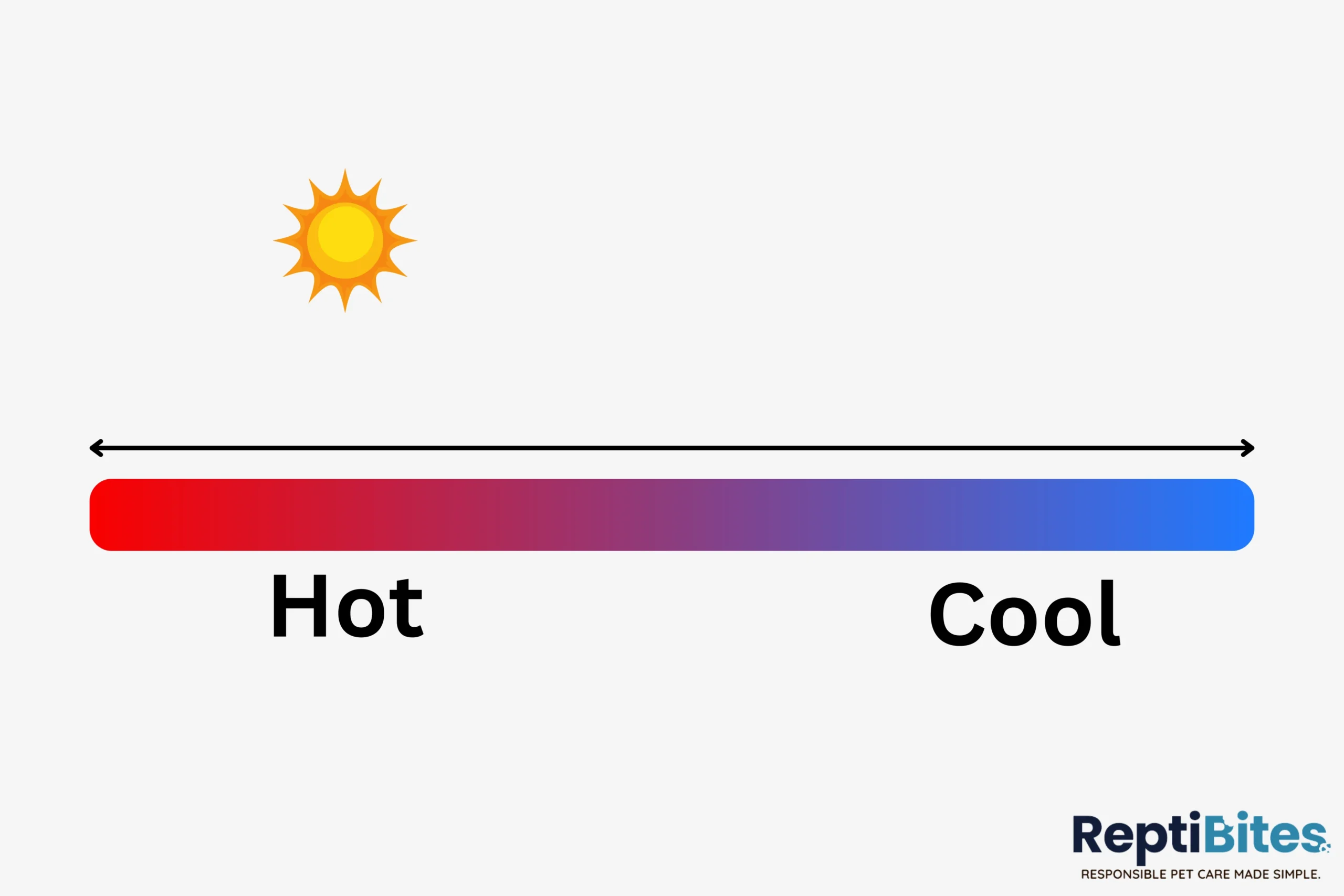
In reality, temperature gradient occurs in 3D, more like this:
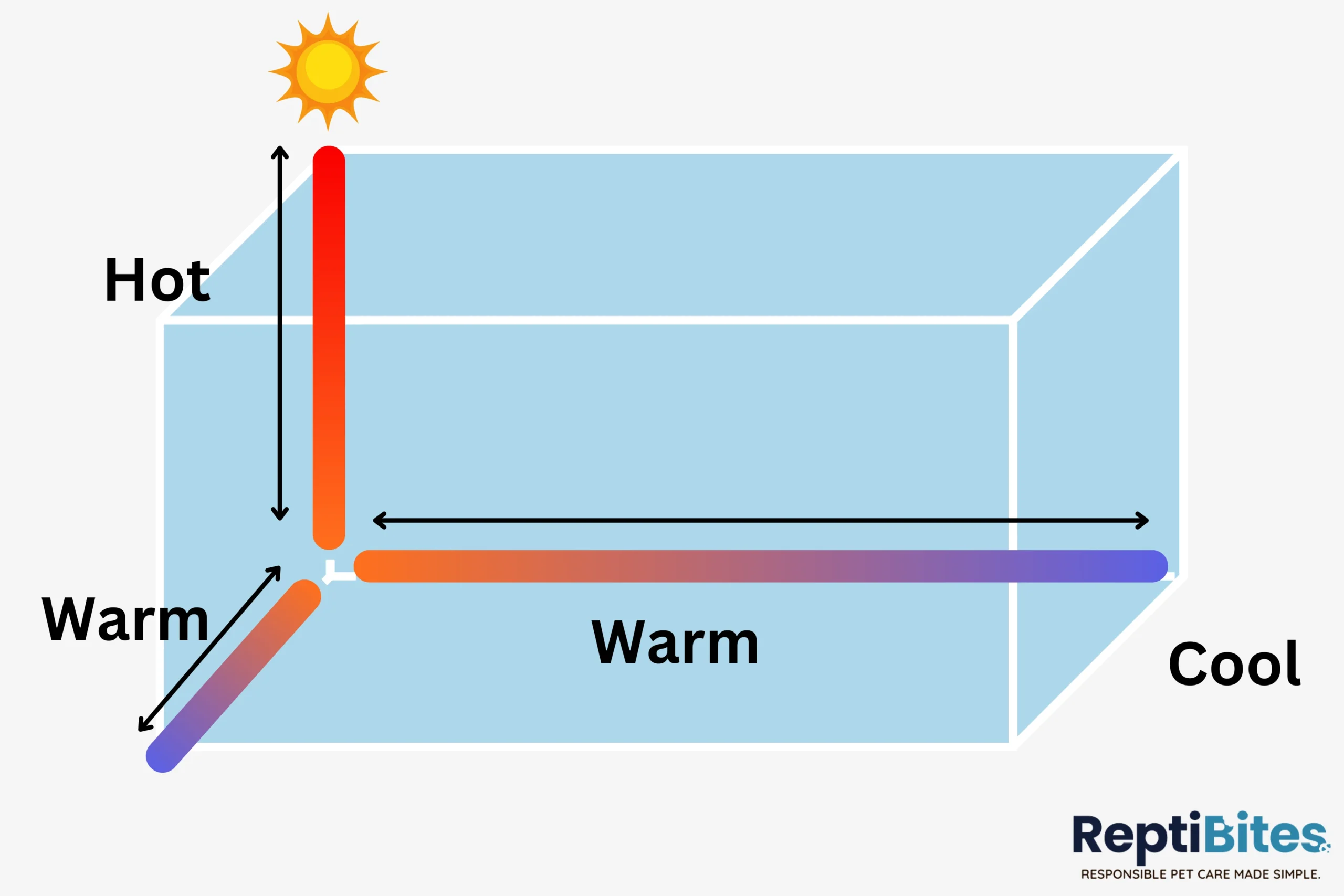
This is an important thing to keep in mind as you aim to provide your micro-habits. You can use the length, depth, and height of your enclosure.
Cleaning/Maintenance
Working with the current body of scientific literature concerning exotic animal care in captivity makes it difficult to establish a clear-cut cleaning and maintenance regime.
Ultimately, this will depend on your animal and setup. Good enclosure hygiene is important. It is generally recommended by most reputable care information sources to remove uneaten food, soiled substrate, or feces daily.
If your enclosure has a foul odor, it’s a sure sign things aren’t being kept clean enough. It’s likely a good idea to replace all substrate 2-3 times a year to prevent the growth of undesirable bacteria, fungi, and pathogens from getting out of hand.
Alternatively, creating a bio-active setup can help cut down on this cleaning and maintenance work significantly.

